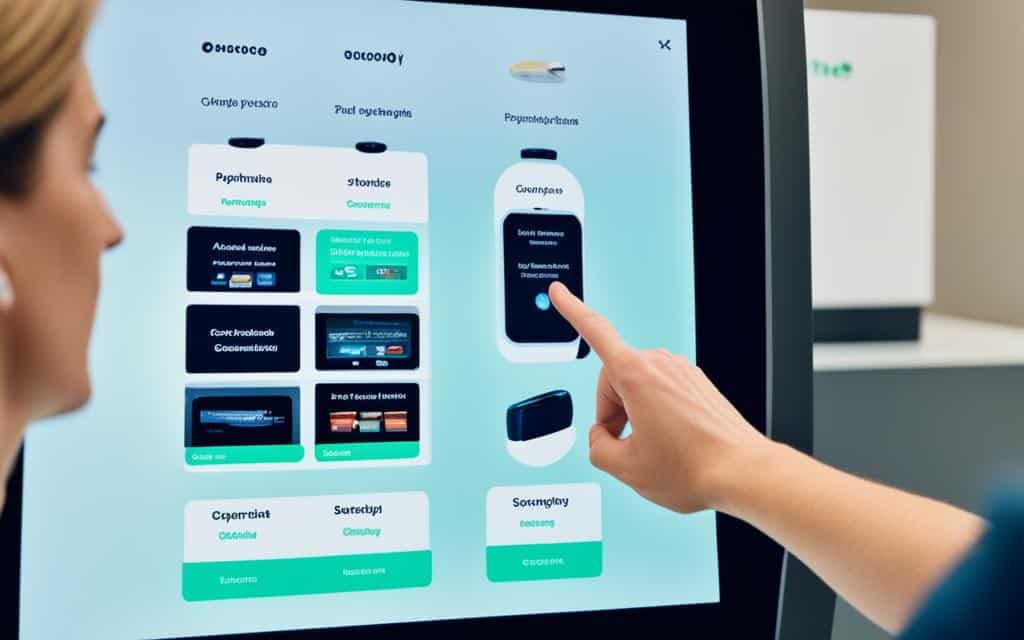Table of Contents
When it comes to optimizing outcomes for your business, effective product discovery is key. By integrating innovative design features, you can enhance the process of discovering and understanding valuable product features. This not only improves user adoption and engagement but also sets your product apart from the competition.
Implementing feature discovery techniques, such as change logs, UX copy, and contextual pop-ups, can educate users about specific features and highlight the benefits of using them. Companies like Drift, Airtable, and Heap have successfully employed feature discovery to drive product-led growth.
To optimize product discovery, prioritize the user experience and emphasize the advantages of the features. Employ a combination of methods, including change logs, contextual onboarding, and analytics monitoring. By doing so, you can ensure that your users fully understand and utilize the value your product offers.
What is Feature Discovery and Why Does it Matter?
Feature discovery plays a vital role in the success of a SaaS product. It involves informing users about specific features and highlighting the benefits they can offer. The process is crucial for user adoption and engagement since users cannot utilize features they are unaware of. For product-led growth, feature discovery is key to educate users and remove any barriers to adoption. It proves to be more effective than traditional product marketing methods like blog posts and social media. Various techniques can be employed to achieve feature discovery, including change logs, contextual onboarding, and analytics monitoring. By prioritizing feature discovery, companies can enhance user satisfaction, reduce support costs, improve onboarding, and showcase the value proposition of their products.
Effective feature discovery ensures that users are aware of the full capabilities of a SaaS product, resulting in higher adoption rates and improved user satisfaction. For product marketing, incorporating feature discovery not only educates users but also removes any barriers that may hinder adoption. By implementing a combination of techniques such as change logs, contextual onboarding, and analytics monitoring, companies can effectively highlight the features that add value to their products. This leads to better user engagement and increased customer loyalty.
Feature discovery also proves to be more effective than traditional product marketing methods like blog posts and social media. While these methods can highlight product features and benefits, they may not reach all users or convey the information effectively. Feature discovery, on the other hand, allows for a targeted approach, ensuring that users are informed about features relevant to them and are more likely to utilize them. This targeted approach leads to higher user adoption rates and a better overall user experience.
Examples of Companies Using Feature Discovery
Many customer-centric companies have successfully used feature discovery techniques to enhance product adoption. Some notable examples include:
- Zoom: Zoom is a widely recognized video conferencing platform that utilizes feature discovery to educate users about new functionalities. Through tooltips, in-app notifications, and interactive guides, Zoom encourages users to explore and adopt its various video and audio features.
- Slack: Slack, a popular team collaboration tool, employs feature discovery methods such as change logs and pop-ups to inform users about new enhancements and encourage their adoption. Through clear and concise release notes, Slack keeps users informed about new features and guides them on how to use them effectively.
- Canva: Canva, a graphic design platform, utilizes feature discovery techniques like interactive guides and in-app notifications to educate users about new design features. Canva also provides comprehensive guides and webinars to help users understand and make the most of these features.
- Dropbox: Dropbox, a cloud storage service, focuses on feature discovery to improve user adoption. They employ various methods, including tooltips and contextual pop-ups, to educate users about new features and demonstrate their benefits. Dropbox also provides walkthroughs and comprehensive guides to assist users in effectively utilizing the new functionalities.
- Adobe: Adobe, a leading creative software company, uses feature discovery techniques to enhance user adoption. Through in-app notifications, tooltips, and interactive tutorials, Adobe educates users about new tools and features available in its suite of creative software.
These companies prioritize feature discovery to educate their users and ensure a smooth transition to new functionalities. By following their examples, companies can improve product adoption and foster a more competent and satisfied user base, ultimately driving business growth.
How to Use Feature Discovery to Improve Product Adoption
To enhance product adoption, companies can strategically incorporate feature discovery into user interactions. By incorporating feature walkthroughs in user onboarding, companies can guide users step-by-step through the most valuable features of their products. Personalization and incentivization can also enhance product adoption by targeting specific user behaviours and preferences and rewarding active use of the product.
Additionally, companies can publish release notes and changelogs to keep users informed about new features and updates. In-app alerts, pop-ups, and targeted messaging can further guide users towards feature adoption. Incorporating user feedback is essential to improving product adoption, as it allows companies to gather insights and make informed decisions about enhancing feature discovery.
Strategic Incorporation of Feature Walkthroughs
One effective way to improve product adoption is by incorporating feature walkthroughs in the user onboarding process. Feature walkthroughs provide step-by-step guidance on how to use the most valuable features of a product, ensuring that users are aware of the full range of functionalities available to them.
By using strategically placed tooltips, annotations, or interactive guides, companies can effectively introduce users to new features and encourage their adoption. This method helps users understand the value proposition of the features and demonstrates how they can be integrated into their workflow for better outcomes.
Personalization and Incentivization
Personalization and incentivization techniques can significantly enhance product adoption. By tailoring the user experience based on specific behaviours and preferences, companies can create a more engaging and relevant experience for their users.
For example, companies can use personalized recommendations or suggestions to highlight features that are most likely to be valuable to individual users. This personal touch helps users discover features they may have overlooked and encourages their adoption.
Additionally, companies can create incentives for users to actively use new features. This can be done through rewards, badges, or exclusive access to additional features or content. By incentivizing active use of the product, companies can foster a sense of engagement and promote feature adoption.
Release Notes and Changelogs
Keeping users informed about new features and updates is crucial for promoting feature discovery and adoption. Companies can publish release notes and changelogs detailing the latest additions and improvements to their products.
These release notes can be made available through the product’s website, in-app notifications, or email newsletters. Providing clear and concise information about new features helps users understand the value they can derive from them and encourages their exploration and adoption.
In-App Alerts, Pop-ups, and Targeted Messaging
In-app alerts, pop-ups, and targeted messaging can be effective tools for guiding users towards feature adoption. Companies can use strategically placed alerts and pop-ups within the product interface to notify users about new features or important updates.
Targeted messaging can also be employed to deliver personalized notifications to specific user segments, highlighting features that are relevant to their needs or usage patterns. By providing timely and contextual information, companies can capture users’ attention and drive them towards feature discovery and adoption.
User Feedback for Continuous Improvement
Incorporating user feedback is essential for improving product adoption and enhancing feature discovery. By actively seeking and listening to user feedback, companies can gain valuable insights into user preferences, pain points, and barriers to adoption.
This feedback can inform future feature development and help prioritize feature discovery efforts. By addressing user concerns and iteratively improving the product based on their feedback, companies can create a more user-centric experience and drive higher levels of product adoption.
Enhancing Product Discovery in E-commerce
In the e-commerce industry, enhanced product discovery plays a vital role in optimizing the online shopping experience. It encompasses the process of assisting online visitors in efficiently finding and exploring relevant products. One of the key factors in achieving this is the implementation of software solutions that offer advanced search functionalities, personalized product recommendations, and improved product listings.
“Enhanced product discovery is pivotal in the e-commerce industry as it helps online visitors efficiently find and explore relevant products.”
By incorporating advanced features such as autocomplete, typo tolerance and correction, merchandising techniques, dynamic filters, and engaging product recommendations, the overall product discovery experience in e-commerce can be significantly enhanced. These functionalities not only improve user engagement but also increase relevancy and make the shopping process easier and more enjoyable for potential customers.
Here’s a comparison of the must-have features that can greatly improve product discovery in e-commerce:
| Feature | Description |
|---|---|
| Advanced Search | Implementing powerful search capabilities with filters and sorting options for enhanced product exploration. |
| Personalized Product Recommendations | Utilizing algorithms to suggest products based on user preferences, browsing history, and purchase behavior. |
| Improved Product Listings | Optimizing product descriptions, images, and categorization to provide clear and concise information. |
| Autocomplete | Offering suggestions as users type in search queries, speeding up the product discovery process. |
| Typo Tolerance and Correction | Correcting misspellings or typos in search queries to ensure accurate and relevant search results. |
| Merchandising | Strategically arranging and promoting products to highlight popular, new, or recommended items. |
| Dynamic Filters | Allowing users to refine product search results based on specific attributes or criteria. |
| Product Recommendations | Displaying related or complementary products to encourage cross-selling and upselling. |
By incorporating these essential features, e-commerce businesses can enhance customer engagement, increase conversions, and boost overall revenue. The seamless product discovery experience created as a result of these functionalities leads to improved user satisfaction and loyalty.
Benefit from Enhanced Functionality and Delightful User Experience
Implementing enhanced product discovery functionality in e-commerce not only benefits customers but also provides a competitive edge to businesses. By streamlining the product exploration process and offering relevant recommendations, businesses can drive customer retention and attract new customers.
Discovering the perfect product should be a delightful experience for online shoppers, and with the right tools and strategies, e-commerce businesses can achieve just that.
https://www.youtube.com/watch?v=flE5DlrLTg0
With advanced features and improved user experience, businesses can stand out in the crowded e-commerce landscape and create a loyal customer base. By continuously optimizing the product discovery process and leveraging user feedback, businesses can stay one step ahead and deliver a seamless shopping experience that keeps customers coming back.
Conclusion
Enhancing product discovery through innovative design features is essential for improving user adoption and engagement in various industries, including SaaS and e-commerce.
Feature discovery techniques, such as change logs, tooltips, and interactive guides, aid users in discovering and understanding new features, thereby enhancing their product discovery experience.
Moreover, personalized product recommendations, optimized search functionalities, and improved product listings contribute further to the enhanced product discovery in the e-commerce sector.
By prioritizing product discovery and incorporating valuable user feedback, businesses can optimize the user experience, increase customer satisfaction, and ultimately drive business growth. Embracing new design features and functionalities is key to revolutionizing the approach to product discovery, leading to improved outcomes in the market.
FAQ
What is feature discovery?
Feature discovery is the process of alerting users to specific features in a product. It aims to inform users about the existence of features and sell their benefits.
Why is feature discovery important?
Effective feature discovery is crucial for user adoption and engagement, as users cannot utilize features they are unaware of. It also helps educate users and remove adoption barriers, making it essential for product-led growth.
How can feature discovery be implemented?
Feature discovery can be achieved through various techniques, including change logs, contextual onboarding, and analytics monitoring. Incorporating user feedback is also essential for improving product adoption.
Can you provide examples of companies using feature discovery?
Yes, some customer-centric companies that successfully use feature discovery include Zoom, Slack, Canva, Dropbox, and Adobe.
How can feature discovery be used to improve product adoption?
By strategically incorporating feature walkthroughs in user onboarding, personalizing the user experience, publishing release notes, and using in-app alerts and targeted messaging.
How can product discovery be enhanced in e-commerce?
Product discovery in e-commerce can be enhanced through advanced search features, personalized product recommendations, optimized product listings, and other innovative design features.
What are the benefits of enhancing product discovery?
Enhancing product discovery can optimize the user experience, increase customer satisfaction, and ultimately drive business growth by improving user adoption and engagement.













